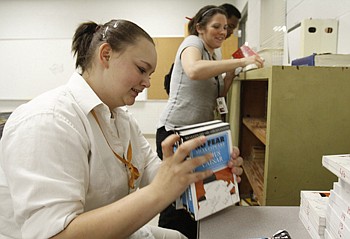Glenn Perry came to teach at Howard School of Academics and Technology fresh out of college with wild ideas about being part of a miracle.
At the time, about eight years ago, the historic but deteriorating inner-city school was on the end of a slow slide to possible closure. Spray paint and penned profanities disfigured walls. Poor graduation rates, in some years as low as 25 percent, had persisted for decades.
In the classroom, Mr. Perry taught some students who had been held back for two or three years. He watched young teachers and principals come in, cut their teeth and move on.
Still, over the years, teachers like Mr. Perry saw change, too. There were small improvements. Graduation rates crept up. Math and reading proficiency improved. Howard insiders talked about a turnaround, but time ran out.
The state has branded the school a failure, identified as one of 13 troubled Tennessee schools to face intervention in the fall from Nashville and a possible takeover.
By the end of next week, state education officials will reveal their plans for Howard, which could include curriculum overhauls and the removal of as many as 50 percent of the teachers.
Mr. Perry and many others are afraid for their jobs and wish they had been given more time.
"I don't think people outside this building can come in once a week and turn this school around," he said. "There is no storybook ending. This isn't a movie ... We are competing with failure here. We have a legacy of failure here."
SET AT THE TOP
Howard's principal Paul Smith, who came to Howard three years ago as a first-time principal, will remain in the school's top post for another year as Howard transitions to the state's Achievement School District.
Within the state-run district, set up in Tennessee's federal Race to the Top application that has earned millions for education reform efforts, four options exist for the 13 schools: close them, turn them into charter schools, replace the principal or replace staff members.
Tennessee Commissioner of Education Tim Webb has not agreed to a Hamilton County proposal to raise Dr. Smith's $77,000 salary by $25,000, but there are plans to increase his pay if the school reaches certain academic goals next year.
Amounts are yet to be determined, said Hamilton County Schools Superintendent Jim Scales..
Dr Scales has lobbied for the state to keep Howard's leadership intact, especially since the school made academic gains in the last three years.
"Who are we going to find to come to Howard that is going to be in a better position to get this done?" he asked. "Dr. Smith has built bonds with the children, the community."
While Howard officials are unsure what state involvement will reform about the school or who will stay to implement the reforms, they are happy about one thing - the money.
The school will get at least $650,000 a year in Race to the Top funding, pulled from a district-wide pool of $49 million and giving Howard money it hasn't had to start programs, recruit teachers and upgrade equipment.
"I gladly welcome state money," Dr. Smith said.
FINDING BRIGHT SPOTS
Students at Howard are just as nervous about what's coming as the administrators.
Sixteen-year-old Tyson Vashaun Jones didn't know what to expect when he came to Howard as a freshman. Like so many kids, he had heard it could be a rough-and-tumble place. Some ninth graders, as old as 17, had children of their own. Others were being raised by siblings. Like him, few had fathers around.
"People said nothing good was going on at Howard," he said.
But he found good things.
Teachers joked with him, he said, and made him feel comfortable. When the school imposed a new dress code in 2008, Tyson learned to tie a tie for the first time. In English class last year, he started dreaming about being a creative writer. When he doubted himself, teachers told him not to.
"I bet if (the state) came and sat in a classroom, they would see Howard in a different light," he said.
Bright spots exist and always have, students say. The question is how to transform the status quo: the academic lagging, the fights, the dropouts. Everyone has a different answer.
ELEMENTS* In seven years, the school has not met federal benchmarks set by No Child Left Behind.* Math proficiency increased from 52 percent in 2008 to 72 percent in 2009.* English proficiency increased from 83 percent in 2008 to 94 percent in 2009.* Graduation rates are 56.5 percent.Source: Howard School of Academics and Technology
Teachers will say they have worked themselves to the bone to raise the school's academic bar. They beg parents for involvement. They attend professional development training weekly. They drive students home from school, buy them supplies and give them rides to the grocery store when their parents can't.
"People assume we aren't working hard," said Chris Akridge, a four-year teacher at Howard who resigned this year. "We have tried everything we can think of ... If (the state) knew how to turn Howard around, they should have told us a long time ago."
And students say they shouldn't be blamed, either.
Clayton Mason, a 10th grader at Howard whose family members have attended the school since 1926, said kids in the community grow up too fast, faced with the kind of heartbreak and decisions that can make school seem irrelevant.
"They expect us to live up to expectations of those that have been more fortunate," said Clayton, who grew up in public housing. "Until you've been inside of Howard, you don't know."
Continue reading by following these links to related stories:
Article: House honors Howard High students of 1960s
